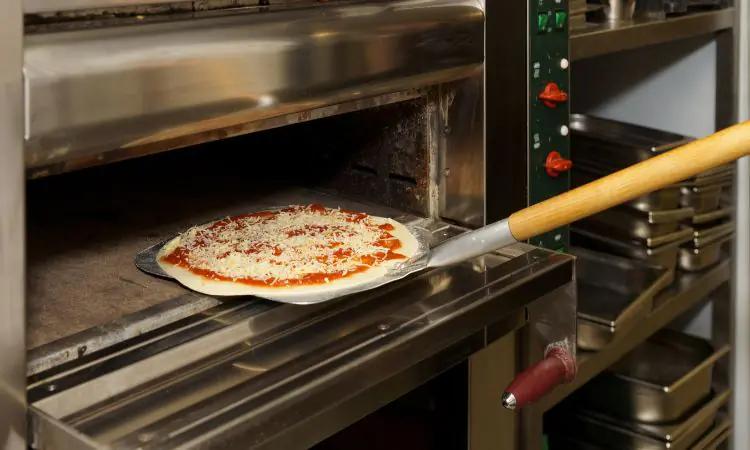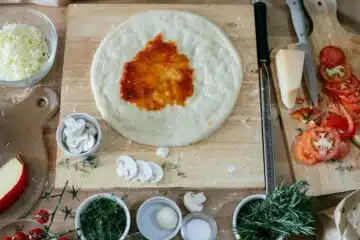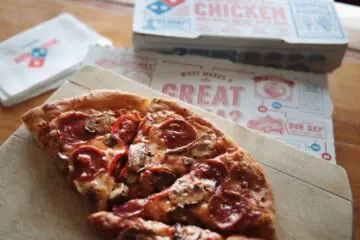Yes, you can place pizza directly on the oven rack for a crisper crust. Use a baking sheet if the pizza is frozen or has a thin crust.
Cooking the perfect pizza at home often hinges on how it’s baked. Placing the pizza directly on the oven rack allows heat to circulate evenly across the pizza, resulting in a crispy crust. This method is especially effective for thick or pre-cooked crusts that can hold their shape and integrity without support.
Pizzas with lots of toppings or those with fragile crusts may benefit from the stability of a baking sheet to prevent sagging or dripping. The key to a delicious homemade pizza experience lies in understanding your pizza’s needs and your oven’s capabilities. By mastering the art of pizza placement within the oven, you will ensure that every slice is as savory and satisfying as it should be.

The Great Pizza Debate: To Rack Or Not To Rack?
Imagine this: It’s pizza night. The oven hums in the background, its heat beckoning the raw dough to transform into a delicious masterpiece. But a question looms—should your pizza perch directly upon the oven rack? Let’s dive into the pros and cons of this popular method.
Pros And Cons Of Direct Oven Rack Baking
Placing pizza on the oven rack promises a crispy crust. It lets hot air circulate freely around the dough. See the key points below:
- Crunchier Crust: Heat directly crisps the bottom.
- Even Cooking: No part gets more heat than another.
- Quick Prep: No pan? No problem!
But it’s not all perfect:
- Cheese Drips: Melted cheese may fall.
- Difficult Removal: Moving a hot pizza can be a challenge.
- Cleanup: Drips might require oven cleaning later.
The Fear Of Dropping Cheese: A Valid Concern?
Losing cheese to the oven’s depths is tragic. Yes, dropped cheese is a valid concern.
| Concern | Why It Matters | Hacks |
| Stuck Cheese | It’s a waste; it burns and smells. | Trim edges; check halfway. |
| Harder Cleaning | Charred cheese is tough to scrub off. | Pre-clean the oven; use the foil below. |
| Pizza Shape | Without support, pizza may warp. | Use a pizza stone or baking sheet. |
If anxiety hits at the thought of a cheese avalanche, consider these tips: trim any overhanging cheese, use a baking sheet below, or invest in a pizza stone.

Pizzeria Secrets: Mimicking The Perfect Crust At Home
Unlocking the secrets to that irresistible pizzeria-style pizza crust at home is a quest many embark on. It’s all about heat, texture, and technique. With the right approach, your kitchen oven can produce results that rival your local pizzeria. Ready to learn how? Dive into professional insights and transform your home-cooked pizza.
What Professional Chefs Say About Oven Rack Pizza
Professional chefs advocate for oven rack baking, citing higher heat exposure as a critical factor. This makes the crust crisp and evenly cooked. Here’s why they recommend it:
- Air Circulation: Oven racks allow heat to circulate freely, cooking the crust evenly.
- Direct Heat: The crust comes in direct contact with heat, creating a firm base and crunchy edges.
For best results, preheat your oven with a pizza stone or baking sheet on the rack. This will mimic a commercial pizza oven’s floor, offering a superb crunch to your crust.
Transferring Techniques From Commercial Ovens To Your Kitchen
Adapting commercial oven techniques at home is simple. Here’s how:
- Preheat: Start by preheating your oven to the highest temperature with a baking stone or inverted baking sheet in place.
- Assembly: Assemble your pizza on parchment paper for easy transfer.
- Sliding Technique: Slide the pizza with the parchment directly onto the preheated stone or sheet.
- Bake: Bake until the edges are golden and the cheese bubbles with joy.
Remember to monitor the pizza for a consistent golden crust. Use these techniques, and you may become the go-to pizza chef in your circle of friends!
Exploring The Science Of Heat And Pizza
When you slide a pizza into the oven, you start a dance of heat, dough, and toppings. Each element of this kitchen ballet plays a vital role in crafting the perfect pizza. For pizza lovers and food science enthusiasts alike, understanding how heat transforms a simple dough into a mouth-watering meal reveals why the method of baking is crucial.
How Oven Racks Influence Cooking Temperatures
Placing a pizza directly on an oven rack allows heat to encompass the dough. This results in a balanced bake. Here’s the breakdown:
- Top rack placement:
Ideal for brown, bubbly cheese.
- Middle rack placement:
Even cooking is excellent for most recipes.
- Bottom rack placement:
intense heat for a crisp base.
Adjustments to the rack level can tweak the texture and color of your pizza. Experiment with these positions to discover your preferences.
The Role Of Air Circulation In Achieving Crispy Bases
A pizza’s base needs hot circulating air to develop crispiness. Direct rack placement achieves this by exposing the pizza to optimal airflow. Compare this to a pizza pan, which can block air and retain moisture, leading to potential sogginess. Some points to remember:
- Air can move freely around a pizza on a rack.
- Pizza stones or perforated pans also permit air circulation. They mimic the effects of a brick oven.
- Use caution with thin crust or heavily topped pizzas; they may sag or drip.
For pizzas baked with crisp edges and perfectly melted toppings, mind your oven rack choice and the role of air circulation. Every home oven is unique, so leveraging these tips can upgrade your homemade pizza game to professional heights.
Real Pizza Aficionados Speak: Trials And Results
When it comes to making pizza at home, everyone is looking for that perfect slice. Does putting your pizza directly on the oven rack make a difference? Real pizza fans have put their ovens to the test. They’ve experimented with different methods to achieve that irresistible, crispy crust we all crave. Let’s dive into the experiences of these enthusiasts and see what wisdom they have to share about their trials and results.
Surveying Home Cooks: Oven Rack Vs. Baking Stone/steel
Keen home cooks have conducted their experiments to find the superior method for a perfect pizza crust. Some swear by the simplicity of the oven rack, while others champion the traditional baking stone or the modern steel. Let’s break down the findings:
- Oven Rack: Users find it convenient and easy. Pizzas get a decently cooked bottom.
- Baking Stone: Helps distribute heat evenly. It’s excellent for a consistently cooked crust.
- Baking Steel: Known for faster cooking times. It achieves a professionally crispy base.
Success Stories: Crispy Crusts And Kitchen Innovations
Many pizza lovers have shared their success stories. The end goal was always the same: achieving that dreamy, crackly crust. Here’s what’s worked for them:
- Preheating the oven with the baking surface inside.
- A combination of oven racks and stone/steel is used for different cooking stages.
- Experimenting with homemade pizza directly on the rack to encourage airflow.
One innovative approach includes a two-step baking process. Pizza starts on a stone or steel and finishes on the rack. This method might yield the balanced texture you seek on your homemade pie!
| Method | Crispness | Convenience | Popularity |
| Oven Rack | Good | High | Common among beginners |
| Baking Stone | Very Good | Moderate | Preferred by traditionalists |
| Baking Steel | Excellent | Low (due to weight) | Up and coming among aficionados |
Guiding The Home Chef: Best Practices For Rack Baking
Placing pizza on the oven rack is a common practice. It can create a perfectly crisp base. But doing it right needs careful attention. Here are the best practices for rack baking to achieve that mouth-watering pizza without any kitchen disasters.
Tips To Prevent Cheese Meltdowns And Messes
Stop cheese spills before they start. Use these tips to keep your oven clean:
- Pre-cook toppings that release moisture.
- Cheese barriers prevent dripping. Place cheese in the center.
- Use a pizza screen for support without sacrificing crispiness.
- Parchment paper can catch spills. Trim it to fit the pizza’s size.
- Quick cleanup ensures easy maintenance. A baking sheet below catches falls.
Mastering The Art Of Pizza Rotation For Even Cooking
Pizza rotation is crucial for uniform cooking. Follow these steps:
- Set a timer for halfway through the recommended cooking time.
- Use oven mitts to protect hands from heat.
- Rotate your pizza 180 degrees to ensure even heat distribution.
- Check the crust for golden perfection.
Consistent rotation leads to evenly cooked pizza every time. Enjoy a slice of perfection with these simple tips!
Alternatives To The Oven Rack: Baking Tools For Pizza Lovers
Placing pizza directly on the oven rack can work. Yet, baking tools can enhance your pizza-making game. Different tools affect texture and taste. Let’s look at some favorites among pizza enthusiasts.
The Baking Stone/steel Debate
Baking stones hold heat well, creating a crispy crust. They are porous, which pulls moisture from the dough. Baking steels, however, heat up faster and reach higher temperatures. This leads to a quicker cook and a different crust texture. These are the points in the debate:
- Baking Stone: Great for even cooking; needs preheating.
- Baking Steel: Heats quickly, excellent for a crispy bottom.
Pizza Peels, Pans, And Parchment: Other Baking Methods
Other tools ensure your pizza-making is both easy and effective:
- Pizza Peel: A wooden or metal paddle helps transfer pizza to and from the oven.
- Pizza Pan: These pans often have holes in the bottom. These holes increase airflow. This can lead to a crispy crust.
- Parchment Paper: This paper makes moving pizza easy. Plus, no sticking! But, it can limit crispiness as it blocks direct heat.

Frequently Asked Questions For Are You Supposed To Put Pizza Directly On The Oven Rack
Can Pizza Be Baked On The Oven Rack?
Baking pizza directly on the oven rack is possible. It allows heat to circulate evenly. This results in a crispier crust. Use a pizza stone or pan if preferred.
Is Preheating Necessary For Oven Rack Pizza?
Preheating the oven is essential when baking pizza. It ensures proper crust texture and even cooking. Aim for a temperature of 425-475°F before placing the pizza.
What’s The Benefit Of Pizza On An Oven Rack?
Placing pizza on an oven rack allows better airflow. This means a uniformly cooked crust. It can also reduce baking time compared to using a pan.
How do you prevent pizza from sticking to the oven rack?
Prevent sticking by using semolina flour or cornmeal on the rack. These act as tiny ball bearings. Alternatively, use parchment paper for easy removal.
Conclusion
Baking pizza directly on the oven rack is a choice that hinges on preference and desired crust texture. Opting for this method often results in a perfectly crispy underside. For those unsure, try both rack and tray methods to find your perfect pizza experience.
Remember, a watchful eye ensures optimal results every time. Enjoy your homemade slice of heaven!

As the author of the “Ultimate Pizza Guide: Recipes, Tips & Secrets Revealed,” I’m dedicated to sharing my love for pizza and empowering others to create delicious homemade pizzas with ease. Join me on a journey to uncover the secrets to perfecting your pizza game!


